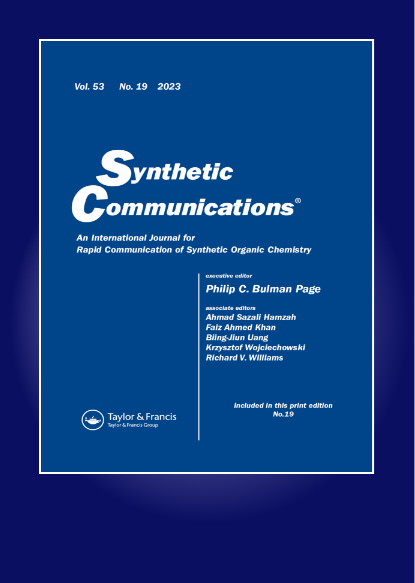Design, synthesis, characterization and biological evaluation of coumarin bound 1,2,3-triazoles using click chemistry
IF 1.8
3区 化学
Q3 CHEMISTRY, ORGANIC
引用次数: 0
Abstract
In an endeavor to invent new antimalarial and antimicrobial agents, a series of coumarin bound 1,4-disubstituted 1,2,3-triazoles was synthesized through Cu(I)-promoted click reaction between coumarin bound terminal alkynes, that is, 4/7-(prop-2-yn-1-yloxy)-2H-chromen-2-one and 2-azido-N-arylpropanamides. The synthesized 1,2,3-triazoles were characterized by FTIR,1H NMR,13C NMR, and HRMS techniques and were assessed for in vitro antimalarial activity against Plasmodium falciparum as well as in vitro antimicrobial activity against four bacterial strains (Staphylococcus aureus, Bacillus subtilis, Escherichia coli, and Klebsiella pneumoniae) and two fungal strains (Candida albicans, Aspergillus niger). Compound 7o [(N-(4-fluorophenyl)-2-(4-(((2-oxo-2H-chromen-7-yl)oxy)methyl)-1H-1,2,3-triazol-1-yl)propanamide)] displayed better activity against P. falciparum while compound 7y [(N-(3-nitrophenyl)-2-(4-(((2-oxo-2H-chromen-7-yl)oxy)methyl)-1H-1,2,3-triazol-1-yl)propanamide)] displayed excellent activity against all the tested bacterial and fungal strains, amongst the synthesized triazoles. Also, the molecular docking studies of the most potent compounds against DNA gyrase (S. aureus) were also performed to have an insight on binding interactions.
利用点击化学设计、合成与香豆素结合的 1,2,3-三唑,并对其进行表征和生物学评价
为了发明新的抗疟和抗菌剂,我们通过 Cu(I)-promoted click reaction(Cu(I)促进香豆素末端炔,即 4/7-(丙-2-炔-1-氧基)-2H-色烯-2-酮和 2-叠氮-N-芳基丙酰胺之间的单击反应)合成了一系列香豆素结合的 1,4-二取代 1,2,3-三唑。通过傅立叶变换红外光谱、1H NMR、13C NMR 和 HRMS 技术对合成的 1,2,3-三唑进行了表征,并评估了它们对恶性疟原虫的体外抗疟活性以及对四种细菌菌株(金黄色葡萄球菌、枯草芽孢杆菌、埃舍拉氏杆菌、痢疾杆菌)的体外抗菌活性、枯草芽孢杆菌、大肠杆菌和肺炎克雷伯菌)和两种真菌菌株(白色念珠菌和黑曲霉)的体外抗菌活性。化合物 7o[(N-(4-氟苯基)-2-(4-(((2-氧代-2H-苯并吡喃-7-基)氧基)甲基)-1H-1,2,3-三唑-1-基)丙酰胺)]对恶性疟原虫显示出更好的活性,而化合物 7c而化合物 7y[(N-(3-硝基苯基)-2-(4-(((2-氧代-2H-苯并吡喃-7-基)氧基)甲基)-1H-1,2,3-三唑-1-基)丙酰胺)]在合成的三唑类化合物中对所有测试的细菌和真菌菌株都显示出了极佳的活性。此外,还对 DNA 回旋酶(金黄色葡萄球菌)作用最强的化合物进行了分子对接研究,以深入了解其结合相互作用。
本文章由计算机程序翻译,如有差异,请以英文原文为准。
求助全文
约1分钟内获得全文
求助全文
来源期刊

Synthetic Communications
化学-有机化学
CiteScore
4.40
自引率
4.80%
发文量
156
审稿时长
4.3 months
期刊介绍:
Synthetic Communications presents communications describing new methods, reagents, and other synthetic work pertaining to organic chemistry with sufficient experimental detail to permit reported reactions to be repeated by a chemist reasonably skilled in the art. In addition, the Journal features short, focused review articles discussing topics within its remit of synthetic organic chemistry.
 求助内容:
求助内容: 应助结果提醒方式:
应助结果提醒方式:


